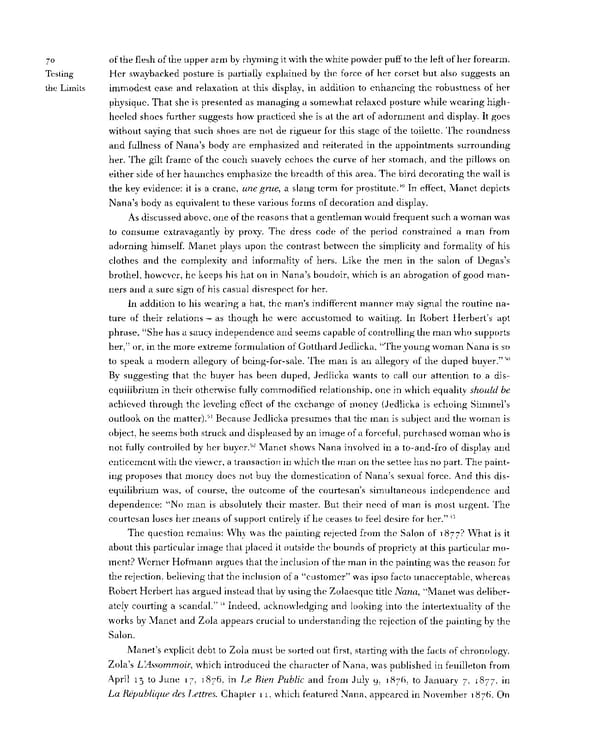70 of the flesh of the upper arm by rhyming it with the white powder puff to the left of her forearm. Testing Her swaybacked posture is partially explained by the force of her corset but also suggests an the Limits immodest ease and relaxation at this display, in addition to enhancing the robustness of her physique. That she is presented as managing a somewhat relaxed posture while wearing high- heeled shoes further suggests how practiced she is at the art of adornment and display. It goes without saying that such shoes are not de rigueur for this stage of the toilette. The roundness and fullness of Nana's body are emphasized and reiterated in the appointments surrounding her. The gilt frame of the couch suavely echoes the curve of her stomach, and the pillows on either side of her haunches emphasize the breadth of this area. The bird decorating the wall is 49 the key evidence: it is a crane, tine grue, a slang term for prostitute. In effect, Manet depicts Nana's body as equivalent to these various forms of decoration and display. As discussed above, one of the reasons that a gentleman would frequent such a woman was to consume extravagantly by proxy. The dress code of the period constrained a man from adorning himself. Manet plays upon the contrast between the simplicity and formality of his clothes and the complexity and informality of hers. Like the men in the salon of Degas's brothel, however, he keeps his hat on in Nana's boudoir, which is an abrogation of good man- ners and a sure sign of his casual disrespect for her. In addition to his wearing a hat, the man's indifferent manner may signal the routine na- ture of their relations — as though he were accustomed to waiting. In Robert Herbert's apt u phrase, She has a saucy independence and seems capable of controlling the man who supports her," or, in the more extreme formulation of Gotthard Jedlicka, "The young woman Nana is so 50 to speak a modern allegory of being-for-sale. The man is an allegory of the duped buyer." By suggesting that the buyer has been duped, Jedlicka wants to call our attention to a dis- equilibrium in their otherwise fully commodified relationship, one in which equality should be achieved through the leveling effect of the exchange of money (Jedlicka is echoing Simmel's 51 outlook on the matter). Because Jedlicka presumes that the man is subject and the woman is object, he seems both struck and displeased by an image of a forceful, purchased woman who is 52 not fully controlled by her buyer. Manet shows Nana involved in a to-and-fro of display and enticement with the viewer, a transaction in which the man on the settee has no part. The paint- ing proposes that money does not buy the domestication of Nana's sexual force. And this dis- equilibrium was, of course, the outcome of the courtesan's simultaneous independence and dependence: "No man is absolutely their master. But their need of man is most urgent. The 53 courtesan loses her means of support entirely if he ceases to feel desire for her." The question remains: Why was the painting rejected from the Salon of 1877? What is it about this particular image that placed it outside the bounds of propriety at this particular mo- ment? Werner Hofmann argues that the inclusion of the man in the painting was the reason for the rejection, believing that the inclusion of a "customer" was ipso facto unacceptable, whereas Robert Herbert has argued instead that by using the Zolaesque title Nana, "Manet was deliber- 34 ately courting a scandal." Indeed, acknowledging and looking into the intertextuality of the works by Manet and Zola appears crucial to understanding the rejection of the painting by the Salon. Manet's explicit debt to Zola must be sorted out first, starting with the facts of chronology. Zola's UAssommoir, which introduced the character of Nana, was published in feuilleton from April 13 to June 17, 1876, in Le Bien Public and from July 9, 1876, to January 7, 1877, in La Republique des Lettres. Chapter 11, which featured Nana, appeared in November 1876. On
 Prostitution & Impressionists Page 90 Page 92
Prostitution & Impressionists Page 90 Page 92